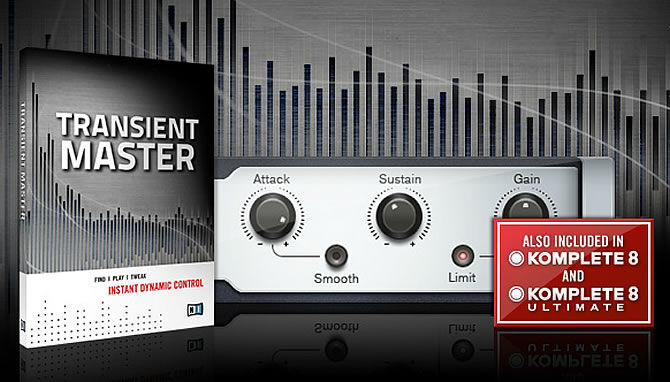Based on a well known studio compressor, Native Instruments Transient Master is a must-have dynamics effect – uniquely powerful, deceptively simple and extremely useful. It’s the go-to tool for positioning drums and percussion, letting you mix from front to back and dial-in just the right amount of space. Native Instruments Transient Master is also a mix-fix for problematic recordings and with only three knobs – Attack, Sustain and Gain – it’s quick and easy to use. Native Instruments Transient Master runs in the Guitar Rig 5 Pro.
Native Instruments Transient Master adds one of the most innovative dynamic processors of the 2000s to the Guitar Rig 5 Pro Rack. It successfully recreates envelope modeling and sonic character of its renowned hardware predecessor while making your audio material even easier to shape.
What Does the Native Instruments Transient Master Do?
Native Instruments Transient Master allows you to emphasize or attenuate the transients of your audio material, i.e. manipulate its attack and sustain phases. Unlike most dynamic processing units (e.g., compressors or limiters), the Transient Master does not use the level of your signal to decide when to come into effect, but rather modifies the envelopes of every attack and sustain phase. A notable benefit of this processing is that it affects all parts of the signal, whatever their level is. This musical approach retains the natural character of your sound while keeping operation simple and intuitive: Adjust the desired amount of accentuation for the attack and/or sustain phases and you’re all set!
Common Applications
Transient Master can be of great use in various studio and live music situations. Here are some typical examples:
Drums: By increasing the attacks on a bass drum or snare drum track, you can build powerful percussive sounds without running the risk of damaging the natural sounding of your recording. Furthermore, shortening the sustain phase on a drum track or loop can help you define its position in your mix — at more extreme settings, this can add an electronic touch to your drums.
Guitar and bass: Transient Master provides a special Smooth mode that is specifically designed for guitar and bass sounds. Depending on your style of playing, you can use the unit as a versatile shaping tool for your guitar/bass sound. For example, increasing the attack of a rhythmic guitar or a funky bass line can make it sound more aggressive and bring it to the front of your mix. Inversely, reducing the attack allows you to soften your sound. By increasing the sustain, you can add a subtle reverb-like effect that unveils the acoustic character of your instrument.
In addition to these applications, there is room for your own experiments. Native Instruments Transient Master is very useful for mixing drums, guitars, pianos, plucked strings – anything with intrinsic attack. It gives you another axis to work on. As well as panning left and right, you can position things quite precisely at the front or back of a mix without juggling volume levels. Generally, more Attack and less Sustain brings a sound to the front; less Attack and more Sustain blends a sound into the background. Even before EQ, you can effectively ‘stack’ sounds according to the priorities of a particular mix.
Native Instruments Transient Master will be available for $119 / 99 EUR. from September 1 2011 at the Native Instruments Online Shop.


